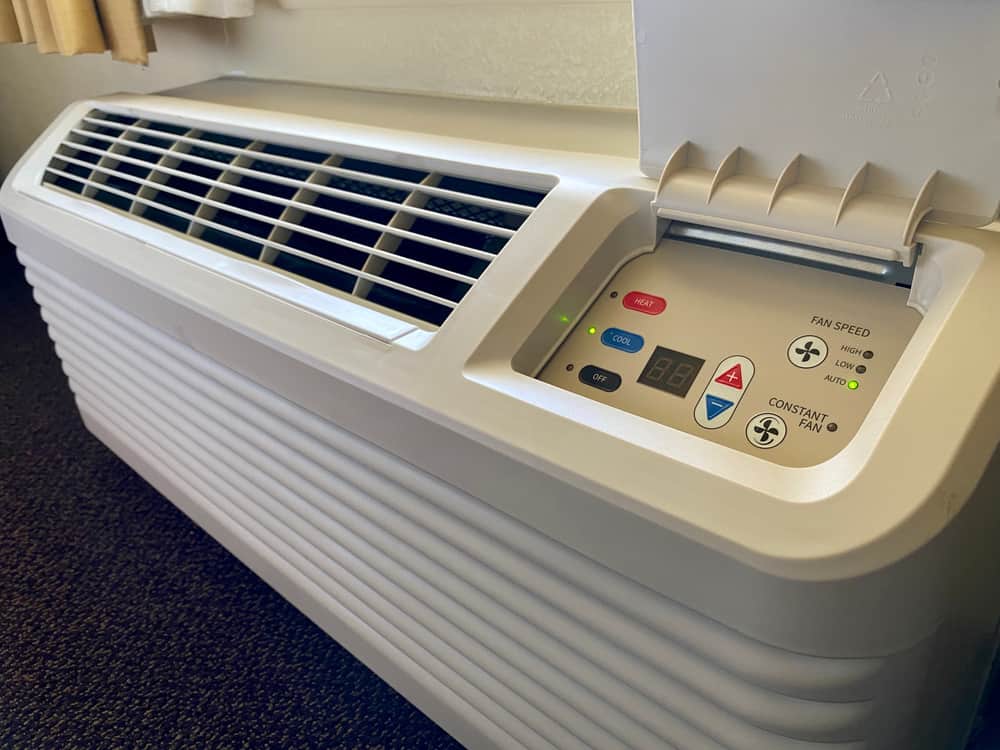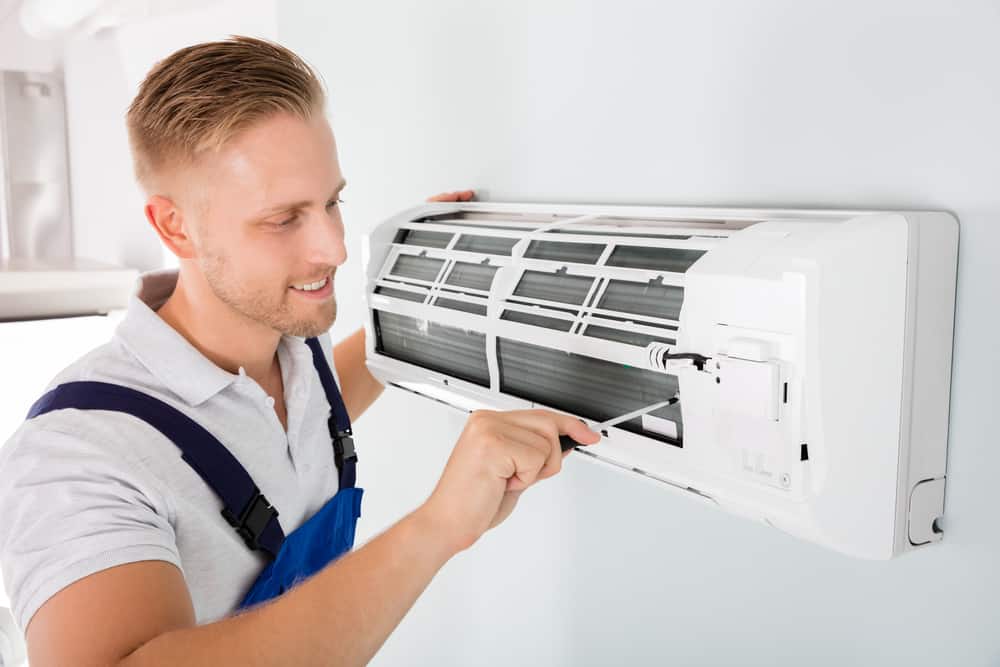Summary:
What Makes PTAC Repair Different From Regular AC Service
PTAC units aren’t your typical window air conditioners. These through-the-wall systems combine heating and cooling in one compact unit, making them the go-to choice for Queens apartments, condos, and smaller homes.
The complexity comes from their dual function and permanent installation. Unlike a window unit you can simply remove, PTAC systems require specialized knowledge of both refrigeration and heating components. Most general HVAC technicians don’t have the specific training needed to properly diagnose and repair these units.
That’s why you’ll often hear horror stories about $800 repair bills for simple fixes. When technicians don’t understand PTAC systems, they tend to overcomplicate repairs or replace parts unnecessarily.
Common PTAC Problems Queens Residents Face
Living in Queens means your PTAC unit works harder than systems in most other cities. The combination of extreme weather swings, urban air pollution, and aging building infrastructure creates unique challenges that show up as specific problems.
The most frequent issue we see is actuator failure during winter months. This small component controls hot water or steam flow through your heating coils. When it fails, your PTAC blows cold air even when set to heat. Many companies will quote you $400 to $800 for this repair, but it’s actually a straightforward on-site fix when you know what you’re doing.
Filter clogs happen faster in Queens due to higher dust and debris levels. What starts as reduced airflow quickly escalates to compressor strain if ignored. Your system works overtime trying to push air through blocked filters, driving up your electric bill and wearing out components prematurely.
Refrigerant leaks are another common problem, especially in older units. NYC’s temperature extremes cause expansion and contraction that can stress connections over time. Low refrigerant doesn’t just mean poor cooling – it forces your compressor to work harder, potentially leading to complete system failure.
Coil fouling is particularly bad in urban environments. Grime builds up on both evaporator and condenser coils, acting like insulation that prevents proper heat transfer. Your PTAC runs constantly but never reaches the temperature you’ve set, wasting energy and money.
Why DIY PTAC Repair Usually Backfires
We understand the temptation to tackle PTAC repairs yourself, especially when facing potentially high service costs. But PTAC systems have some unique characteristics that make DIY repairs risky and often more expensive in the long run.
First, these units contain both electrical and refrigeration components under pressure. Improper handling can result in refrigerant leaks, electrical shorts, or even personal injury. Unlike window units, PTACs are permanently installed and connected to your building’s electrical system, requiring specific safety protocols.
The diagnostic process requires specialized tools and knowledge. What looks like a compressor problem might actually be a control board issue, a refrigerant leak, or even something as simple as a dirty sensor. Without proper testing equipment, you’re essentially guessing at the solution.
Parts availability is another major hurdle. PTAC units use specific components that aren’t readily available at home improvement stores. Ordering the wrong part means delays, return hassles, and potentially voiding any existing warranties. Professional repair services maintain relationships with suppliers and stock common parts for immediate repairs.
Perhaps most importantly, improper repairs can create bigger problems. We’ve seen DIY attempts turn simple filter changes into compressor failures, or electrical work that creates fire hazards. What might have been a $200 repair becomes a $1,500 replacement, plus potential safety issues for your family.
Insurance and liability concerns also come into play. If a DIY repair causes property damage or injury, your homeowner’s insurance may not cover the costs. Professional repair services carry insurance and warranties that protect you from these risks.
How Professional PTAC Maintenance Saves Money Long-Term
Most Queens residents treat PTAC maintenance like dental checkups – they know it’s important but keep putting it off until something hurts. This reactive approach costs significantly more than preventive care.
Professional maintenance catches small problems before they become expensive repairs. A loose electrical connection identified during routine service prevents a potential compressor failure later. Clean coils and fresh filters keep your system running efficiently, reducing energy costs and extending equipment life.
The numbers tell the story clearly. Properly maintained PTAC units can improve efficiency by 15-25%, which translates to immediate savings on your utility bill. When you’re already paying 38% more than the national average for electricity in Queens, that efficiency gain makes a real difference in your budget.
What Professional PTAC Maintenance Actually Includes
Real PTAC maintenance goes far beyond changing filters and wiping down surfaces. Professional service addresses the specific challenges these units face in NYC’s demanding environment.
The process starts with a comprehensive system inspection, checking electrical connections, refrigerant levels, and control functions. We test both heating and cooling modes to ensure proper operation across all temperature ranges. This isn’t a quick visual check – it’s a systematic evaluation of every component.
Coil cleaning is particularly important for PTAC units. Both evaporator and condenser coils accumulate grime that acts like insulation, preventing proper heat transfer. Professional cleaning removes this buildup using specialized equipment and cleaning solutions that won’t damage delicate fins or components.
Filter maintenance involves more than simple replacement. We inspect the entire air filtration system, including checking for bypass air that reduces efficiency. Proper filter selection matters too – the wrong filter type can restrict airflow or allow contaminants to pass through.
Refrigerant system service includes checking for leaks, verifying proper charge levels, and testing system pressures. This requires specialized gauges and knowledge of EPA regulations. Improper refrigerant handling isn’t just ineffective – it’s illegal and environmentally harmful.
Electrical system inspection covers all connections, controls, and safety devices. PTAC units have multiple electrical components that can develop problems over time. Loose connections create heat and potential fire hazards, while failing controls can cause system damage or inefficient operation.
When Repair Makes Sense vs When Replacement Is Better
Knowing when to repair versus replace your PTAC unit can save you thousands of dollars and prevent ongoing frustration. The decision isn’t always obvious, but there are clear guidelines that help determine the most cost-effective approach.
Our general rule is straightforward: if repair costs are less than 30% of a new unit’s price and this is your first major issue, repair makes sense. However, when repair costs exceed 50% of replacement cost, or if you’ve had multiple repairs in the past year, replacement becomes the smarter investment.
Age plays a crucial role in this decision. PTAC units typically last 5-10 years depending on usage and maintenance. Units approaching the 7-year mark with significant problems are often better candidates for replacement, especially if parts are becoming scarce or expensive.
Energy efficiency considerations matter too. Older PTAC units operate at much lower efficiency levels than current models. If your unit is over 8 years old, the energy savings from a new high-efficiency model can offset the replacement cost over time. This is particularly important in Queens where electricity costs are already 38% above the national average.
Refrigerant type is another factor many homeowners overlook. Older units may use refrigerants that are being phased out, making repairs more expensive and eventually impossible. If your system uses R-22 refrigerant, replacement with a modern unit using environmentally-friendly refrigerant makes long-term sense.
Frequency of repairs tells the whole story. If your PTAC unit has needed service 2-3 times in the past year, it’s becoming a money pit. Each repair visit costs money, causes inconvenience, and often doesn’t solve the underlying problems. At that point, replacement provides better value and peace of mind.
Getting Reliable PTAC Repair Service in Queens NY
Your PTAC system is too important to trust to inexperienced technicians or attempt risky DIY repairs. When it breaks down, you need service from professionals who understand these specialized units and can fix them right the first time.
The key is finding a company with specific PTAC expertise, proper licensing and insurance, and a track record of satisfied customers in the Queens area. Don’t settle for general HVAC companies that treat PTAC repair as an afterthought.
For reliable, professional PTAC repair service in Queens, contact Lion-Air Enterprises. Our five decades of experience and specialized knowledge ensure your comfort is restored quickly and affordably.



